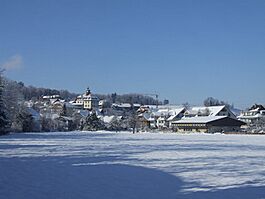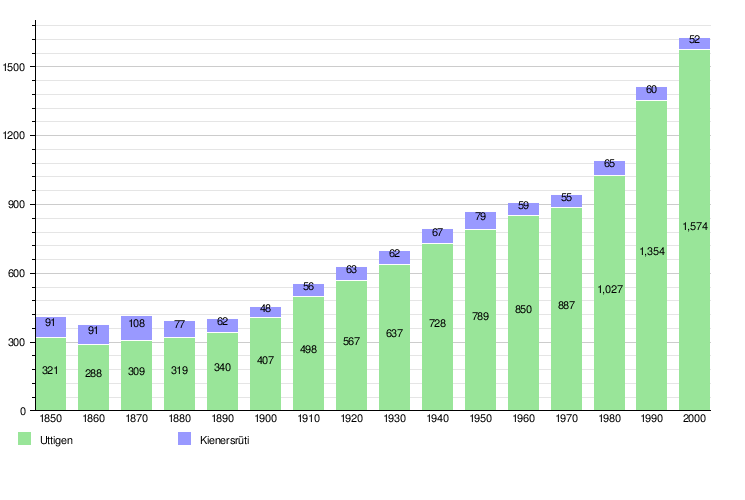Uttigen facts for kids
Quick facts for kids
Uttigen
|
||
|---|---|---|
 |
||
|
||
| Country | Switzerland | |
| Canton | Bern | |
| District | Thun | |
| Area | ||
| • Total | 3.81 km2 (1.47 sq mi) | |
| Elevation | 544 m (1,785 ft) | |
| Population
(Dec 2020 )
|
||
| • Total | 2,153 | |
| • Density | 565.1/km2 (1,463.6/sq mi) | |
| Postal code |
3628
|
|
| Surrounded by | Heimberg, Jaberg, Kiesen, Kirchdorf, Uetendorf | |
Uttigen is a small town, also called a municipality, in Switzerland. It is located in the canton of Bern, within the Thun area. On January 1, 2014, another small town called Kienersrüti joined with Uttigen.
Contents
- History of Uttigen: A Journey Through Time
- Geography: Where Uttigen Is Located
- Coat of Arms: Uttigen's Symbol
- People of Uttigen: Demographics
- Historic Population: How Uttigen Has Grown
- Economy: How People Make a Living
- Religion: Beliefs in Uttigen
- Education: Learning in Uttigen
- Notable People from Uttigen
- See also
History of Uttigen: A Journey Through Time
Uttigen was first written about in the year 894. Back then, it was called Utingun.
Early Settlements and Ancient Finds
The very first signs of people living in this area are a grave mound and what seems to be a Roman-era villa (a large Roman house). We don't know exactly when the grave mound was made. Several graves from the Early Middle Ages (a time long ago, after the Roman Empire) have also been found here.
Uttigen Castle: A Stronghold of the Past
By the 1200s, Uttigen Castle was built. It stood on a rocky hill above where the village is today. This castle had a big square keep (the main tower) and strong, high walls around it. Uttigen Castle was one of the largest forts in the Bern area. It was important because it controlled a main road and a river that boats could use. These paths connected the Bernese Oberland (a mountain region) with towns on the Swiss Plateau.
In 1271, a noble family called the Freiherr von Wädenswil owned the castle. They also controlled other areas like Unspunnen and Frutigen. In 1285, the castle's church was mentioned in an old book. It was one of twelve churches around Lake Thun.
In the 1300s, the von Wädenswil family ended. The Freiherr von Kramburg family then took over Uttigen Castle and village. They held it for a short time before it went to Heinrich von Resti in 1355.
Changes in Ownership and the Hospital of Thun
In the 1400s, the castle, village, and lands were split into two parts. Families from Thun and Burgdorf each owned half. Slowly, between 1476 and 1521, the Hospital in Thun bought or received both halves. In 1521, the Hospital combined Uttigen with Uetendorf to create one court (a ruling area).
After the French invaded Switzerland in 1798, the Hospital lost its power over Uttigen. When the French rule ended in 1803, Uttigen became part of the District of Seftigen. Uttigen Castle was left empty and fell apart over time.
Village Life and Modern Growth
The village church was destroyed by fire in 1536 and was not rebuilt. After the fire, Uttigen became part of the parish (church district) of Kirchdorf. The villagers tried to change this until 1579, when they were at least given their own cemetery.
In 1859, a train station opened in Uttigen. This connected the small farming village to bigger cities nearby. Projects to control the Aare and Zulg rivers in the 1860s and 1884 helped protect the village from floods. These projects also created new farmland.
Uttigen started to grow slowly. This growth sped up in the 1970s when exits for the A6 motorway (a major highway) were built near the town. By the 2000s, Uttigen became part of the larger agglomeration (a group of towns that have grown together) of Thun.
In 2005, farming provided only 12% of jobs in Uttigen. Industry and trade provided 45% of jobs. Uttigen has a primary school (for younger kids) and a Realschule (for middle schoolers). Older students go to school in Uetendorf.
Kienersrüti: A Small Farming Community
We don't know much about the early history of Kienersrüti. It was a small farming community. It likely grew from nearby villages like Noflen. After Bern became Protestant, Kienersrüti was probably grouped with other villages. It was part of the Kirchdorf church district.
Even though it usually had fewer than 100 people, Kienersrüti was its own town from the 1700s until 2014. Today, it is still a small farming community. About two-thirds of its workers travel to jobs in nearby towns and cities.
Geography: Where Uttigen Is Located
After Kienersrüti joined, Uttigen now covers an area of 3.81 km2 (1.47 sq mi). Before the merger, it was about 3 km2 (1.2 sq mi).
In 2012, about 46.2% of the land was used for farming. About 32.5% was covered by forests. The rest, about 18.0%, was settled with buildings or roads. A small part, 2.0%, was rivers or lakes.
Most of the farming land (30.5%) is used for growing crops. About 14.4% is for pastures (where animals graze). A small part (1.3%) is for orchards or vineyards. All the water in the town is flowing water, like rivers.
On December 31, 2009, the old district of Seftigen was closed. The next day, January 1, 2010, Uttigen joined the new Verwaltungskreis Thun district.
Coat of Arms: Uttigen's Symbol
The blazon (description) of Uttigen's coat of arms is: Azure an Oar and a Pike both Or in slatire. This means it shows a blue shield with a golden oar and a golden pike (a type of spear) crossed over each other.
People of Uttigen: Demographics
Uttigen has a population of 2,153 people. In 2011, about 4.8% of the people living there were foreign nationals (people from other countries). The population grew by 2.3% between 2010 and 2011. Most of this growth (1.6%) was from people moving into the town.
Most people in Uttigen (96.2%) speak German as their main language. A small number speak French (0.7%) or English (0.6%).
In 2008, about 48.9% of the population was male and 51.1% was female. Most people (about 80%) were born in Switzerland. About 24.9% were born in Uttigen itself.
In 2011, children and teenagers (0–19 years old) made up 23.9% of the population. Adults (20–64 years old) made up 61.9%, and seniors (over 64 years old) made up 14.2%.
In 2000, there were 672 single people in Uttigen. There were 750 married people, 77 widows or widowers, and 75 divorced people.
In 2010, there were 204 homes with only one person living in them. There were 49 homes with five or more people. In 2011, single-family homes made up 62.2% of all housing in the town.
Historic Population: How Uttigen Has Grown
This chart shows how the population of Uttigen and Kienersrüti has changed over time:

Economy: How People Make a Living
In 2011, Uttigen had a low unemployment rate of 1.09%. This means most people who wanted to work had jobs. In 2008, 258 people worked in the town.
- Primary sector: 23 people worked in farming and related businesses.
- Secondary sector: 124 people worked in manufacturing, mining, and construction.
- Tertiary sector: 111 people worked in services, like sales, transportation, hotels, education, and healthcare.
In 2008, there were 206 full-time jobs. Most of these were in construction (63 jobs). Other jobs were in manufacturing (10 jobs) and mining (22 jobs). In the service sector, many jobs were in sales and repairs (26 jobs) and education (13 jobs).
In 2000, 113 workers came into Uttigen for work. However, 698 workers left Uttigen to work elsewhere. This means more people from Uttigen work outside the town than inside it. About 64.1% of the workers in Uttigen also lived there.
About 25.8% of workers used public transportation to get to work. A larger number, 51.2%, used a private car.
Religion: Beliefs in Uttigen
Based on the 2000 census:
- Most people (76.6%) belonged to the Swiss Reformed Church (a Protestant church).
- About 7.9% were Roman Catholic.
- Smaller groups included Orthodox Christians, Christian Catholics, and other Christian churches.
- A very small number were Muslim, Buddhist, or Hindu.
- About 4.70% of the population did not belong to any church.
Education: Learning in Uttigen
In Uttigen, about 62.6% of people have finished non-mandatory upper secondary education (like high school). About 17.5% have gone on to higher education, such as university or a specialized college.
The school system in Bern canton starts with one year of optional Kindergarten. Then, there are six years of Primary school. After that, students have three years of mandatory lower Secondary school. In secondary school, students are grouped by their abilities. After lower secondary, students can continue their education or start an apprenticeship (learning a trade on the job).
During the 2011-12 school year, 219 students attended schools in Uttigen.
- There were 2 kindergarten classes with 39 students.
- There were 8 primary classes with 151 students.
- There were 2 lower secondary classes with 29 students.
In 2000, 154 students lived and went to school in Uttigen. One student came from another town to study there. Also, 76 students from Uttigen went to schools outside the town.
Notable People from Uttigen
- Christine von Wattenwyl (1888–1964), a Swiss religious worker.
See also
 In Spanish: Uttigen para niños
In Spanish: Uttigen para niños





